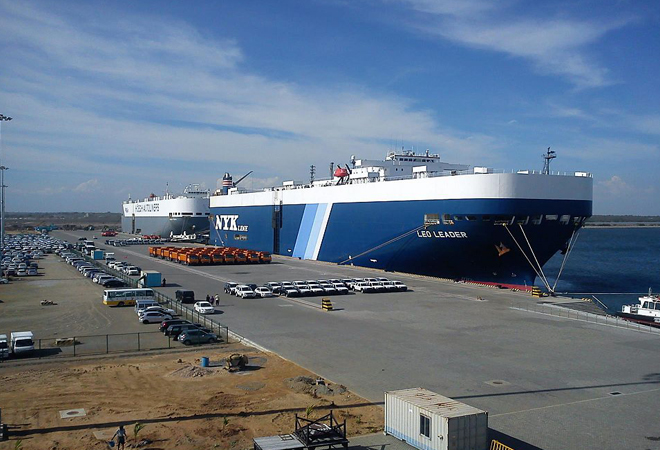ABHIJIT SINGH
 Sri Lanka’s decision earlier this month to move a naval unit to Hambantota port, now leased to the China Merchant Ports Holdings Ltd for period of 99 years, isn’t good news for New Delhi. With reports in the media that China is considering ‘gifting’ a frigate to the Sri Lankan Navy, it seems clear that a process for the creation of a Chinese naval outpost in India’s near-neighbourhood has just begun. Beijing’s move creates the grounds for the insertion of PLAN training and support teams at Sri Lanka’s naval command, which is bound to result in the positioning of greater Chinese naval assets at the facility.
Sri Lanka’s decision earlier this month to move a naval unit to Hambantota port, now leased to the China Merchant Ports Holdings Ltd for period of 99 years, isn’t good news for New Delhi. With reports in the media that China is considering ‘gifting’ a frigate to the Sri Lankan Navy, it seems clear that a process for the creation of a Chinese naval outpost in India’s near-neighbourhood has just begun. Beijing’s move creates the grounds for the insertion of PLAN training and support teams at Sri Lanka’s naval command, which is bound to result in the positioning of greater Chinese naval assets at the facility.
To be sure, Hambantota’s maritime significance for Beijing has never been in doubt. The port’s location at the southern extremity of Sri Lanka, overlooking South Asia’s vital sea lanes, makes it an important commercial asset for China. But Beijing’s investment in Hambantota also has a strategic dimension. As a recent New York Times report revealed, the deal involved huge sums of money contributed to former President Mahinda Rajapaksa’s re-election campaign in 2015. When Beijing’s revised its loan interest rates from 1-2% floating to 6.3%, it became clear Hambantota was more than just an investment opportunity for China.
Colombo, of course, rejects suggestions that its deal with CMPorts is driven by anything other than economics. When it comes to China, Sri Lankan analysts suspect many Indian observers suffer from paranoia that induces zero-sum thinking. New Delhi, they complain, does not give enough credence to Colombo’s assurances that Hambantota port will be civilian and under the explicit control of Sri Lankan authorities.
Yet, India’s misgivings deserve closer examination. If the PLAN’s salami-slicing approach in the South China Sea is any indication, China’s gameplan in Hambantota is likely to be one of incremental control. In the near-term, Beijing would conform to the commercial template, avoiding any naval deployments to the port city. Over time, however, there is little doubt that China’s leadership would seek to leverage its possession for strategic gains.
Beijing will perhaps start by asking Colombo to allow naval access for logistics. Since Sri Lanka had already announced a naval command at Hambantota, Colombo won’t have much option but to accommodate Beijing’s request. China would then offer to assist Sri Lanka in upgrading existing communications facilities, gradually expanding the enterprise into an intelligence, surveillance, and reconnaissance outpost. Eventually, China would aim to establish a dual use commercial/ military facility for forward-arming, restocking and refuelling of high-end naval assets. Willingly or inadvertently, Colombo would be co-opted into the plan.
The complex nature of China’s investment at Hambantota says something about Beijing’s strategic motives. Since August 2017, when the deal was first signed, Colombo has claimed control over Hambantota International Port Services Ltd. (HIPS), the holding company in charge of port security. However, CMPorts has publically revealed it holds 58% stakes in the firm (as against Sri Lanka Port Authority’s 42%). With majority stakes in the project, it seems unlikely the Chinese state-owned company will allow Sri Lanka a veto over future PLAN deployments at Hambantota.
Oddly enough, only select portions of the pact have been made public, with the Sri Lankan government hesitant to place the document in parliament for a thorough discussion. It is possible CMPorts insisted on the inclusion of clauses that clarified its superior stakeholder status in resolving disagreements. The prospects of greater Chinese undersea presence in the region may have caused Ranil Wickremesinghe, the Sri Lankan Prime Minister, to call for the deployment of anti-submarine warfare platforms in Sri Lanka’s near-seas. It also appears to be the single most important reason India is seeking control of the loss-making Mattala airport at Hambantota.
But New Delhi’s Indian Ocean woes aren’t confined to Sri Lanka. Across the Indian Ocean’s littorals, the Chinese navy has been preparing to establish a stronger security presence. On Pakistan’s Makran coast, the PLAN has deployed regularly, including at Gwadar, also constructed by CMPorts. Earlier this year, the PLAN is said to have initiated talks with the Pakistan military for another outpost at Jiwani.
In Maldives, China reportedly has a plan to construct a naval facility at Gadhoo Island in the Southern Laamu atoll, close to the one and a half degree channel — the main trading route between Africa and Asia. This has coincided with a downturn in India-Maldives relations, and a refusal by Male to extend visas for Indian security personnel deployed on the southern Islands, ostensibly to prevent surveillance over Chinese assets in the region.
More troubling for India is China’s increased openness about its naval force projections in the Indian Ocean. A deployment of a three-ship task force in January 2018 was perceived by some as a warning for Delhi to desist from using military force in the Maldives. Not surprisingly, the PLAN is more indifferent than ever to Indian sensitivities in South Asia. Beijing seems to be signalling to New Delhi that it will not let the latter’s security concerns come in the way of its own strategic ambitions.
Many in India’s strategic community then seem convinced Hambantota will be a crown jewel in China’s “string of pearls” strategy.
Perhaps, it is the price India will pay for not making its red lines in the Indian Ocean clear to China.
No comments:
Post a Comment